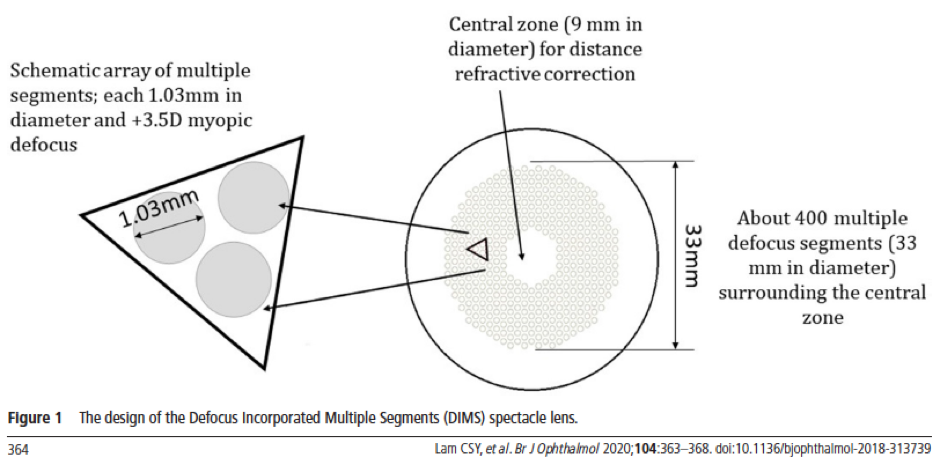The newest myopia controlling spectacles can both correct and control myopia as well as the most effective contact lens options. This is a highly appealing prospect for myopia control practice, as spectacles are likely an easier place to start, and not all children are ready or willing to wear contact lenses.
眼镜镜头近视控制现在已经从渐进式添加和双焦点选项的最早转变为新一代的近视,从而控制了特定的设计。这些是投资于研发的大量时间和金钱的产物。
How do Defocus Incorporated Multiple Segments (DIMS) and Highly Aspherical Lenslet Target or H.A.L.T. technology spectacle lenses work? Here we investigate and compare their design, presumed mechanism and comparative efficacy for myopia control, based on published research.
What are DIMS and H.A.L.T. technology?
Both DIMS and H.A.L.T. technology spectacle lenses take a step beyond the traditional spectacle to behave more like a myopia controlling contact lens. The benefit of a contact lens is that it moves with the eye, so the same optical profile is provided to the central and peripheral retina regardless of the angle of view. This is easy to imagine in the case of a soft multifocal or myopia controlling contact lens, worn on the eye during the day. In the case of orthokeratology, the treatment is 'fixed' through the overnight corneal profile change.
Think of DIMS and H.A.L.T. technology as like a single vision lens for myopia correction, with an overlaying 'treatment zone' for myopia control.
- Each has a clear single vision distance zone in the centre of the lens, and a 'background' of single vision correction in the periphery of the lens
- Each has a surrounding zone of lenslets to create a differential myopic defocus across the retina, with spaces in between them for the single vision correction
- Each behaves like a single vision lens in that they不要改变渐进式添加或双焦点眼镜镜头的住宿或双眼视觉功能
- Each should be fit like a single vision lens, with careful attention paid to measuring the fitting height to ensure the child makes the most of the clear central zone for best acuity.
While of course an eye moves behind a spectacle lens, these new lenses can be thought of as 'behaving more like a myopia controlling contact lens' because when the child looks away from the clear central zone, they are receiving simultaneous in-focus information from the single vision distance correction (falling on the retinal plane) and myopic defocus information (falling somewhere in front of the retinal plane).
Perhaps this is why their myopia control efficacy results are seeming to exceed any of the previous spectacle lens solutions, and equaling that of dual focus soft and orthokeratology contact lenses. Let's go further to understand DIMS and H.A.L.T. technology.
How do they work?
当涉及近视控制机制的理论时,长期以来的竞争者是peripheral defocus theory, whereby the peripheral retina receives myopic defocus as a slow-down or stop signal for eye growth. This has been shown in animal models - Earl Smith III is arguably the world's leading researcher in this area and you can read a他从2010年开始的摘要演讲.
The more recent thought has evolved to thesimultaneous myopic retinal defocus theory.Think of this as two planes of focus - one being on the retina to correct myopia, and the other in front of the retina for myopic defocus - which could be anywhere across the retina and not just in the 'periphery'. The latest research on this in animal models, again by Earl Smith and colleagues, has sought to understand where on the retina (eg. how far into the periphery) and how much defocus difference is required. To learn more about this, start by reading the introduction inthis December 2020 paper, here.
DIMS技术致力于创建同时散焦的概念,during both distance and near viewing - one plane on the retina due to the single vision zone(s) of the lens, and one plane creating myopic defocus due to the +3.50D defocus lenslets.1
The H.A.L.T. technology takes this a step further by introducing the concept of a 'volume of myopic defocus'.2This terminology and theory as applied to human interventions is new to the field, although is cited in the clinical trial paper2是在动物研究中使用具有功率梯度的非球形镜头的基础。考虑到这一理论的转变,从两个平面的同时散焦(一个在视网膜上纠正近视,另一个是在视网膜前的近视散焦)到在视网膜视网膜前的三维“体积”的“体积”。不同的屈光度。
Defocus融合了多个片段(DIM)-Hoya Miyosmart
Defocus Incorporated Multiple Segments (DIMS) technology was designed by Hong Kong Polytechnic University. It is described in the clinical trial paper as "compris[ing] a central optical zone (9 mm in diameter) for correcting distance refractive errors, and an annular multiple focal zone with multiple segments (33 mm in diameter) having a relative positive power (+3.50 D). The diameter of each segment is 1.03 mm. This design simultaneously introduces myopic defocus and provides clear vision for the wearer at all viewing distances. There are multiple foci from myopic defocus at a plane in front of the retina, which would be received as blur images on the retina."1

In thetwo year randomized clinical trial,香港中国儿童8-13岁的近视-1.00至-5.00d,不超过1.50d的Astigmatism,穿着单视距离(SV)或DIMS奇观镜头。两年后(n = 160),平均近视进度为-0.41d vs -0.85d和0.21mm和0.21mm和0.55mm的昏暗和SV,代表50-60%的控制效应。该论文报告说,穿着DIM的儿童中有21.5%在两年内没有近视进展,而戴上SV镜头的儿童只有7%。
在6/6或20/20左右,昏暗的距离和接近敏锐度与SV相似。虽然与SV相比,斜视或双眼视力(BV)异常的儿童被排除在研究之外,但DIMS对近佛罗里亚或住宿的滞后没有影响。
新出版的三年研究由于SV穿着的儿童被转变为昏暗,还显示出持续的良好结果。阅读更多信息近视控制的眼镜镜片:新设计和最新研究。
Efficacy (two year study): Around 50% refractive and 60% axial length efficacy in Hong Kong Chinese children, with an absolute effect of 0.44D lower refraction and 0.34mm less axial elongation in DIMS wearers.
高度非球形列伦特目标(H.A.L.T.)技术 - Essilor Stellest™
Essilor Stellest™被描述为包括高度非球形透镜目标或H.A.L.T.技术中的技术Press Release. The recent publication of the一年临床审判文件2将这些眼镜透镜描述为“具有11个由连续的非球形透镜形成11个同心环的球形前表面(直径为1.1毫米)。没有透镜的透镜面积可提供距离校正。已经计算出远距离校正的几何形状,以产生vomd在视网膜前面以任何偏心率作为近视控制信号(图1)。”下图是从开放式访问纸中的图1。
The clinical trial paper2describes the use of aspherical lenses with a power gradient in animal studies as a basis for use of the highly aspherical lenslets.它指出:“这些非球面镜片并没有像在竞争的散焦镜片上那样关注两个不同的表面,而是以非线性方式连续地偏离光线,从而在视网膜面前创造了三维的光线,该光线在视网膜前创建了三维的光线在本文中,我们称近视散焦(VOMD)的体积更大,即较大的呕吐物,可以减少鸡在雏鸡中的镜头诱导的近视。”,

Arecent publication provided one-year resultsfor an ongoing clinical trial. Chinese children aged 8-13 years with myopia of -0.75D to -4.75D were randomized into either single vision, highly aspherical lenslet (HAL) or slightly aspherical lenslet (SAL) spectacle lenses. After one year, (n=161) myopia progressed -0.81D/0.36mm in SV, -0.48D/0.25mm in SAL and -0.27D/0.13mm in HAL.
在28%的HAL组,9%的SAL和0%的SV组的一年研究中,轴向长度稳定。两组之间的距离和接近敏锐度没有什么不同,距离约为6/6(20/20),近距离为6/7.5(20/30)。Sal或Hal Lens设计对佛罗里亚附近或住宿滞后没有影响。
Efficacy (one year study): Around a 70% refractive and 60% axial length efficacy for HAL and 40% refractive and 30% axial length efficacy for SAL in Chinese children. This is an absolute effect of 0.54D/0.23mm less myopia for HAL wearers and 0.33D/0.11mm less myopia for SAL wearers.
研究摘要two-year clinical trial datahas just been released (n=157), indicating that myopia progressed -1.46D/0.69mm in SV, -1.04D/0.51mm in SAL and -0.66D/0.34mm in HAL. In children who wore their lenses every day for at least 12 hours per day, the absolute myopia control effect compared to SV was 0.99D/0.41mm less myopia in HAL and 0.57D/0.26mm less myopia in SAL.
How do they compare for efficacy?
Currently we have a one year randomized controlled trial for H.A.L.T. technology and two years for DIMS, both published as full scientific papers. Both have been conducted with Chinese children aged 8-13 years as participants, and with similar baseline characteristics. Let's compare the 6-month and 12-month results as provided in both studies.1,2
在这两项研究中,对照组都佩戴了单一视力距离(SV)眼镜镜头。从针对非球形透镜的新研究中,我们将仅采用高度非球形透镜(HAL)组,因为它们具有较大的治疗效果。2

您在这些结果中看到了什么?让我们比较控制和治疗组。请记住,我们无法进行直接统计测试以查看它们是否不同,因此我们正在研究相似性的手段和标准偏差。
- Control groups.每项研究中的单一视力佩戴者在6个月和12个月时都具有相似的轴向长度进展。在6个月时,它们的屈光度进展相似,但是在12个月时,HAL研究SV组的肌无累进展比DIMS SV组高0.26D。
- 治疗组。Similar axial length progression at 12 months in both, arguably slightly more at 6 months in HAL. When it comes to refractive progression, 6 month data looks similar while at 12 months it appears the HAL group have progressed slightly more.
In absolute terms, the children in the HAL study - both treatment and control groups - had slightly more refractive progression than the children in the DIMS study, but their axial length progression was similar.From an axial length perspective, the myopia control effect at 12 months in both studies looks similar.Given that axial length measurement by interferometry techniques is about 10 times more accurate than refraction,3these are the more relevant results.
In relative terms, the percentages are similar. For axial length, DIMS controlled growth by 66% and HAL by 64%. As recent analysis has explained, percentages must be carefully applied only to the duration of the study and not extrapolated further, as percentage treatment effect changes over time.4
DIMS有两年的数据可用,如上所述,两年数据现在可以在research abstract对于H.A.L.T技术。随着发表更多完整的科学论文,请观看此空间以进行进一步的比较。
Read more on spectacle lenses for myopia control
参考
- 林CSY,唐WC,谢霆锋DY, Lee RPK Chun RKM Hasegawa K, Qi H, Hatanaka T, To CH. Defocus Incorporated Multiple Segments (DIMS) spectacle lenses slow myopia progression: a 2-year randomised clinical trial. Br J Ophthalmol. 2020 Mar;104(3):363-368.(link)
- Bao J,Yang A,Huang Y,Li X,Pan Y,Ding C,Lim EW,Zheng J,Spiegel DP,Drobe B,Lu F,Chen H.具有非球形镜头的眼镜镜头的一年近视控制功效。Br J Ophthalmol。2021:318367。(link)
- Wolffsohn JS, Kollbaum PS, Berntsen DA, Atchison DA, Benavente A, Bradley A, Buckhurst H, Collins M, Fujikado T, Hiraoka T, Hirota M, Jones D, Logan NS, Lundstrom L, Torii H, Read SA, Naidoo K. IMI - Clinical Myopia Control Trials and Instrumentation Report.Invest Ophthalmol Vis Sci.2019;60(3):M132-M160.(link)
- Brennan NA,Toubouti YM,Cheng X,Bullimore MA。近视控制功效。PROG视网膜眼睛。2020年11月27日:100923。(link)[Link to Myopia Profile paper review]









